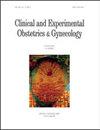术中止吐药对选择性剖宫产鞘内吗啡患者术后恶心呕吐的影响
IF 0.6
4区 医学
Q4 OBSTETRICS & GYNECOLOGY
引用次数: 0
摘要
背景:鞘内注射吗啡(ITM)用于剖宫产(CD)时,术后恶心呕吐(PONV)发生率高达80%,且未进行止吐预防。预防性止吐药可以将这一比率降低50%,但地塞米松在这种情况下没有显示出有效。组合显示出不同的结果。我们调查了在接受ITM的产妇中,不同的止吐药组合用于CD时PONV的发生率。方法:对2016年1月至2017年10月期间接受选择性CD合并ITM的患者进行回顾性单中心队列研究。主要结局是CD后24小时内需要治疗的PONV发生率。通过多变量模型寻找手术后PONV预测因子的相互作用。结果:总共有598名女性参与了这项研究。需要治疗的PONV率为29.1%。PONV发生率随着预防性用药次数的增加而降低(p < 0.001)。未经历PONV的妇女在手术室接受了更多的止吐药(p < 0.001)。ITM剂量与PONV率之间存在剂量效应关系(p < 0.001)。与其他药物联合使用相比,地塞米松单独使用或与其他药物联合使用对PONV没有保护作用(p = 0.08)。结论:我们已经证明,在鞘内使用吗啡的情况下,剖腹产后预防性止吐药的数量与PONV发生率呈反比关系。单独使用地塞米松或与其他药物联合使用地塞米松并不比其他避免使用地塞米松的药物联合使用更有优势。本文章由计算机程序翻译,如有差异,请以英文原文为准。
The effect of intraoperative antiemetics on postoperative nausea and vomiting in patients receiving intrathecal morphine for elective caesarean deliveries
Background: The incidence of postoperative nausea and vomiting (PONV) when intrathecal morphine (ITM) is used for caesarean delivery (CD) is up to 80% without antiemetic prophylaxis. Prophylactic antiemetics can reduce this rate by 50%, except for dexamethasone that did not show to be effective in this context. Combinations showed divergent results. We investigated the incidence of PONV when different combinations of antiemetics were used for CD in parturients receiving ITM.Methods: Retrospective, single centre cohort study of patients undergoing elective CD with ITM between January 2016 and October 2017. The primary outcome was the incidence of PONV requiring treatment in the first 24 hours following CD. Interactions were sought using multivariate modelling for predictors of PONV following surgery. Results: Overall, 598 women were included in the study. The rate of PONV requiring treatment was 29.1%. The rate of PONV decreased with increasing numbers of prophylactic medications (p < 0.001). Women who did not experience PONV received a greater number of antiemetics in the operating room (p < 0.001). There was a dose response relationship between ITM dose and PONV rate (p < 0.001). Dexamethasone, either alone or in combination with other agents was not protective against PONV when compared with other drug combinations (p = 0.08). Conclusions: We have demonstrated an inverse relationship between the number of prophylactic antiemetics given and the rates of PONV after caesarean delivery in the context of intrathecal morphine use. Dexamethasone use, either alone or in conjunction with other drugs did not offer advantages over other combinations where dexamethasone was avoided.
求助全文
通过发布文献求助,成功后即可免费获取论文全文。
去求助
来源期刊
CiteScore
0.50
自引率
0.00%
发文量
241
审稿时长
1 months
期刊介绍:
CEOG is an international, peer-reviewed, open access journal. CEOG covers all aspects of Obstetrics and Gynecology, including obstetrics, prenatal diagnosis, maternal-fetal medicine, perinatology, general gynecology, gynecologic oncology, uro-gynecology, reproductive medicine, infertility, reproductive endocrinology, sexual medicine. All submissions of cutting-edge advances of medical research in the area of women''s health worldwide are encouraged.

 求助内容:
求助内容: 应助结果提醒方式:
应助结果提醒方式:


